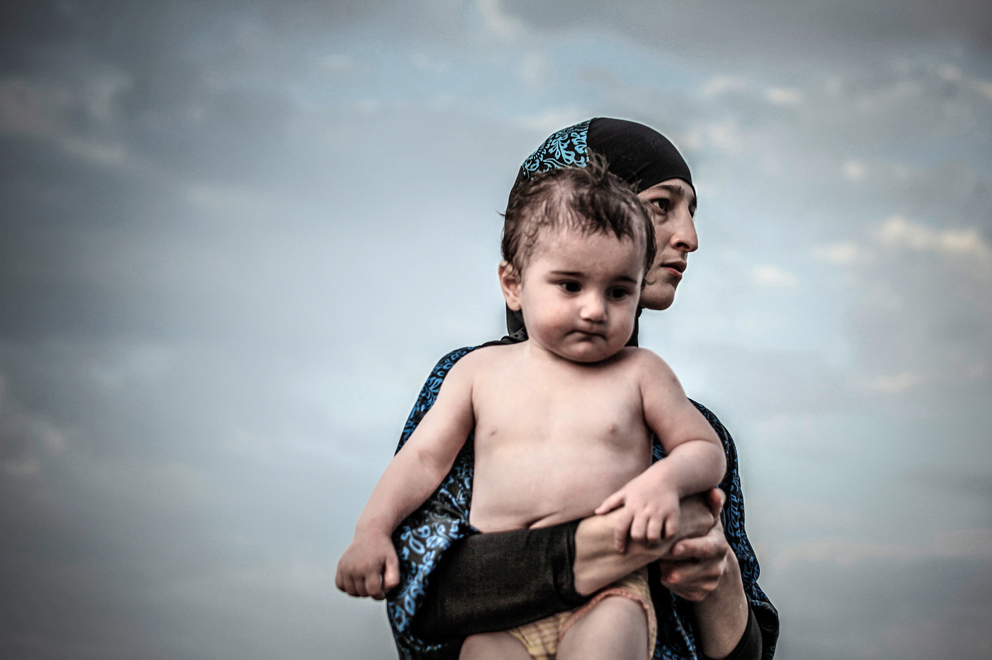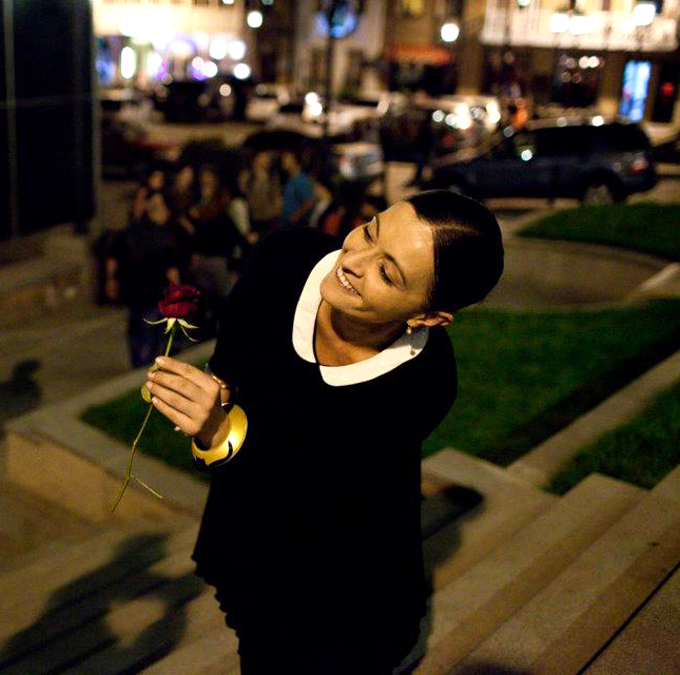 |
(roadsandkingdoms.com) Tbilisi, hillbound city of stone bridges and medieval churches, has alsobecome in recent years a city of photography, a place that some of the best photographers in the world call home. This is partially a fault of geography: it is nestled between the ever-wars of the north Caucasus and the intrigues of Iran, not far from Iraq or Afghanistan. There are additional benefits for photojournalists: low rents, a strong local grappa called chacha, and the ability to smoke almost anywhere at anytime.
But any conversation about why Tbilisi is known for photography should start with Nestan Nijaradze and the Tbilisi Photo Festival that she helps run. Nestan is one of the last true muses of this earth: descendant of Imeretian aristocracy, educated in Paris, ardent defender of humanist Georgia. She has been Artistic Co-Director of the festival from the beginning, and it has always been beautiful, always a crossroad of east and west and north and south. This year it features the kind of brave work it always has—not least the North Caucasus projects shown below. But the 2013 festival, which starts May 28, is more than exposition this year, more than education. This year it’s a referendum on the soul of Georgia.
Here’s why: On May 17, a small silent protest in support of anti-homophobia groups took place as planned in the center of Tbilisi. It was met by a mob of thousands, egged on by Orthodox Christian priests baying for violence. The crowd overwhelmed police lines, attacked the peaceful protesters and, when they were being evacuated, savaged the buses with stones and bricks and bottles. It was a minor miracle that no one died. But the notion that some of us have, that Tbilisi can be a city of both tradition and tolerance, suffered a terrible blow.
I reached Nestan at home in Tbilisi over the weekend.
Roads & Kingdoms: What the hell happened on May 17?
 Nestan Nijaradze: We were expecting that one day there would be something like this, that the church would take control of the crowd. We saw terrible scenes—people beating each other, and priests encouraging it. There were priests running in the streets, battling, with chairs in their hands.
Nestan Nijaradze: We were expecting that one day there would be something like this, that the church would take control of the crowd. We saw terrible scenes—people beating each other, and priests encouraging it. There were priests running in the streets, battling, with chairs in their hands.
Yesterday there was another protest, and again this violence. We were a thousand people, not more. But of course we have to continue. It’s very possible that this would become a radical orthodox country.
R&K: What were they saying as all this was happening?
NN: They were saying, you have sold our country, our traditions. There were saying, you are all—I only know how to say it in French—enculé, fucked in the ass.
But there were also heterosexual people like I am, and we were like, sorry, we are very banal.
R&K: The open-air “night of photography” is a big part of your festival, and it’s on the street. Is that going to change?
NN: We are doing still photo night, still with the Arles Festival, our partner from the beginning.
During this one night in old Tbilisi, we bring in the whole world. We have around 10,000 people who come to this event. The program is already closed, it’s edited. But yesterday morning I got a call from a Georgian magazine, and they asked if they can give us photos from May 17. And of course, we’ll find room. We’ll be able to show this thing to a huge public.
R&K: What’s the value, in times like this, of having a photo festival?
NN: We don’t have a photo festival just to have a photo festival. We want to make the public more mature; to give a larger vision of modernity and the modern world, what’s going on, in Georgia, in the region, the Caucasus, the larger region from Iran and Afghanistan, or Europe; to show it’s not only Georgia, there are not only our own problems. The modern world is a huge structure with a very, very complicated reality. We want to bring it here.
We want to do this through the best photographers, but also through the emerging photographers we find in every corner here when we go looking. There is a group of female photographers who are bringing very interesting work from the north Caucasus. A group of Ukrainians working on Chernobyl. Georgians, Azeris, Armenians. Kurdish Iraqi slideshows on Kirkuk ten years after the invasion and petrol smugglers on the border. Also huge maps of the countries that we put in the program.
R&K: Are you afraid of being targeted?
NN: You know, it’s always possible. We have a transgender series. One by [NOOR photographer] Pep Bonet, another by a young French photographer.
We are expecting of course, that there might be a reaction. We are ready for that, but it doesn’t mean we’re going to cancel the exhibition because of crazy priests running through the street encouraging absolutely stupid young men to beat others.
It’s very important to show the reality of [sexual minorities]. For transsexuals, they’re making this decision that are obliged to be in the sex industry, because it’s the only way for them to continue to exist.
We are not a human rights organization. But we are trying to focus on these stories.
Some of the work is about nightlife and prostitution and drugs, but it’s also about the violence of the world these people are living in. It’s about the economic condition, and how they suffer. The job is to bring this world to this public that suffers from a narrow vision of reality, that has no wish to understand that the modern world is much more complicated and scary.
R&K: Have you talked directly with church leaders about this?
NN: No, no, no. We are trying to be smart. The problem of May 17, first of all, was that all Georgia media was presenting the wrong idea, that the protest was going to be a gay pride parade. It wasn’t: it was a silent march in support of the organizations that protect the rights of sexual minorities. But all the press, during ten days beforehand, they were saying gaypride gaypride gaypride.
We are not looking for any scandals. Even in the titles we put on the show, they are not so easily understood as being about transsexuals, for example. It’s not because we want to complicate it. We are spreading the info without making any big stories about what we’re going to do.
We are ready for anything. But if we think too much about it, it will be impossible to continue. And we have to continue. The festival is just days away.
R&K: Tell me about this work on the North Caucasus in the festival.
NN: We have a few traditions for the festival that we try to maintain from the very beginning. One of them is to try to always show something on the Caucasus. It attracts international public, international media and it’s a chance to show more about the region where Georgia is located. Not just the South Caucasus, but the North, because it’s very important for us, historically.
So in the past we’ve had [Thomas] Dworzak on the Kavkaz, and [Stanley] Greene on Chechnya.
It’s also a tradition to show one country through the work of young photographers. It’s a very interesting trick to show a country through photography. This year’s festival starts a few months before the Sochi Olympics, and Sochi was very political from the beginning, especially for us. So we were thinking okay, why not give the place and space to this huge international event? At the same time, we know what is going on around Sochi, how far it is from the glamour place of winter skiing.
It raises the question: does the larger public know that the Winter Olympics will be held in a very complicated region that still has great risks?
The images are also very interesting, because you see for the last four or five years, the North Caucasus is mostly photographed by Russian photographers. So our shows from the North Caucasus are all Russian photographers, except for Andrea Bruce in Ingushetia.
There are new names, like Maria Turchenkova with her Dagestan work, and Maria Plotnikova in Sochi, and Grozny Nine Cities, which is a joint project of three young photojournalists: Olga Kravets, Maria Morina, and Oksana Yushko. We see the Grozny and Chechnya that pretends to be in normal life, but of course, there’s more to the story.
And, because of the Sochi connection, we decided to include the Sochi Project; they will make a presentation.
R&K: There’s also been a change in government in Georgia since the last festival. The government is a major sponsor. Has that hurt the festival?
NN: You know, it’s incredible timing. It was a really hard year. All the people we were partnering with in government changed. The people in City Hall changed, but they are still supporting us. We never deal directly with the government. Nobody ever asked us what we are doing. Nobody touches us. Nobody asks. They know we’re doing things at a very high level.
This year was the hardest one. But we are doing it, and we are convinced that this is the most important one yet.
[Top image by Oksana Yushko from Grozny Nine Cities]
Nathan Thornburgh is the co-founder of Roads & Kingdoms and the intrepid voice behind @roadskingdoms. He is a former editor and foreign correspondent at TIME Magazine.
facebook: facebook.com











No comments:
Post a Comment